Effect of Spatial Proximity and Human Thermal Plume on the Design of a DIY Human-Centered Thermohygrometric Monitoring System
Abstract
:1. Introduction
1.1. Thermohygrometers in the Built Environment: Field of Application
1.2. Thermal Exchange between Humans and the Environment
- radiation, the primary way the body exchanges heat with the environment; when the air temperature is lower than the skin temperature, the body radiates heat in the form of electromagnetic waves;
- convection, due to convective motion between the body and the surrounding air (or water);
- conduction, typically when a body is in contact with another object, such as a chair;
- respiration, in which a person exhales air that is usually warmer than the surrounding air and releases a small amount of heat.
- temperature gradient between the human body and air temperature, with an increase in the intensity of HTP in terms of thickness and air velocity with an increase in the thermal gradient;
- body posture, with a wider thickness of HTP for an indoor occupant with sedentary activity and lower ascending mean velocity;
- type of clothing, with a sensible reduction of the intensity of HTP when wearing loose clothing due to the thermal insulation effect.
1.3. Motivation of the Proposed Study Based on the Previous Consideration
2. Materials and Methods
2.1. Calibration of Ten iButtons DS1923
2.2. DIY-Based Approach to Construct the Hardware
2.3. Testing Scenarios Considered
- Autumn, with an air temperature in the range of 21 °C, a thermal resistance of clothing of 1.0 clo, a real office scenario with a user who could move freely out of the office (8 November 2022)
- Summer, with an air temperature in the range of 28 °C, a thermal resistance of clothing of 0.5 clo, an office scenario reproduced in the ZEBlab [41] with a user enclosed in an indoor space (14 November 2022)
3. Results
3.1. Comparison in a Controlled Environment of the T Values Monitored by the 10 Sensors
3.2. Comparison in a Controlled Environment of the RH Values Monitored by the 10 Sensors
3.3. Comparison in Real Autumn Scenario of the Air Temperature and Relative Humidity of the 10 Sensors
- on the diagonal, the distribution of each variable;
- at the bottom of the diagonal, the bivariate scatter plots with a fitted line defining the correlation between the two variables (when there is a strong positive correlation between the variables, the points tend to form a line increasing from left to right, i.e., when the value of one variable increases, the value of the other variable also increases, and vice versa for negative correlation);
- at the top of the diagonal, the value of the Pearson correlation coefficient ® and the significance level p-value as asterisks (‘’ if p > 0.05, ‘*’ if p ≤ 0.05, ‘**’ if p ≤ 0.01, ‘***’ if p ≤ 0.001).
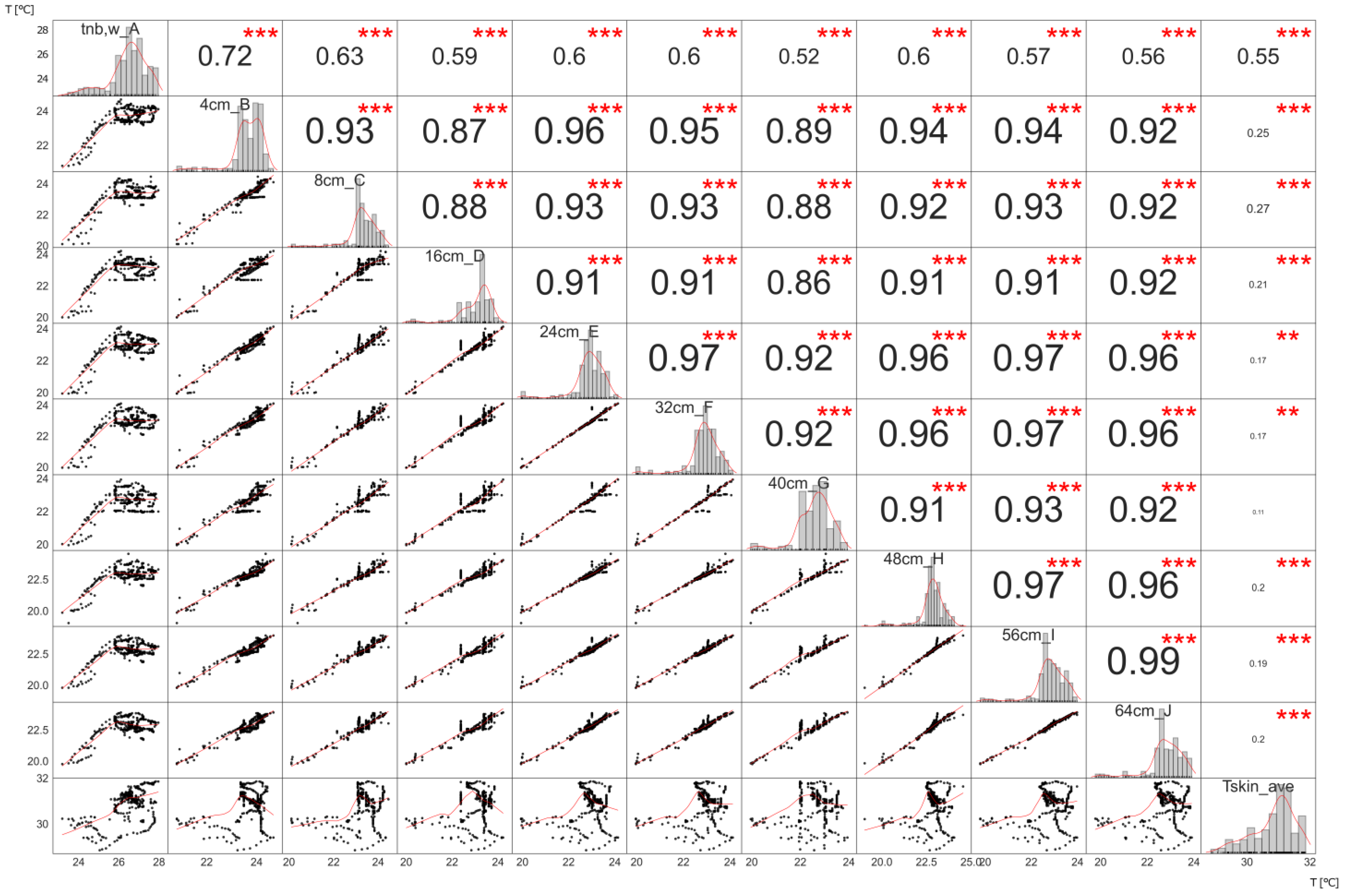
3.4. Comparison in Simulated Summer Scenario of the Air Temperature and Relative Humidity of the 10 Sensors
3.5. Thermal Comfort Index Comparison
4. Discussion
4.1. Thermal Domain Assessed with Wearables in Field Studies
4.2. Thermal Comfort Assessed in Laboratory Studies
5. Conclusions
Author Contributions
Funding
Institutional Review Board Statement
Informed Consent Statement
Data Availability Statement
Conflicts of Interest
References
- Masullo, M.; Maffei, L. The Multidisciplinary Integration of Knowledge, Approaches and Tools: Toward the Sensory Human Experience Centres. Vib. Phys. Syst. 2022, 33. [Google Scholar] [CrossRef]
- Gubbi, J.; Buyya, R.; Marusic, S.; Palaniswami, M. Internet of Things (IoT): A Vision, Architectural Elements, and Future Directions. Future Gener. Comput. Syst. 2013, 29, 1645–1660. [Google Scholar] [CrossRef] [Green Version]
- Atzori, L.; Iera, A.; Morabito, G. The Internet of Things: A Survey. Comput. Netw. 2010, 54, 2787–2805. [Google Scholar] [CrossRef]
- May, M. A DIY Approach to Automating Your Lab. Nature 2019, 569, 587–588. [Google Scholar] [CrossRef] [Green Version]
- Lin, R.; Ho, J.S. A DIY Approach to Wearable Sensor Networks. Nat. Electron. 2021, 4, 771–772. [Google Scholar] [CrossRef]
- Roelands, M.; Plomp, J.; Mansilla, D.C.; Velasco, J.R.; Salhi, I.; Lee, G.M.; Crespi, N.; Santos, F.V.d.; Vachaudez, J.; Bettens, F.; et al. The DiY Smart Experiences Project. In Architecting the Internet of Things; Springer: Berlin/Heidelberg, Germany, 2011; pp. 279–315. [Google Scholar]
- Chu, M.; Song, Y. Analysis of Network Security and Privacy Security Based on AI in IOT Environment. In Proceedings of the 2021 IEEE 4th International Conference on Information Systems and Computer Aided Education (ICISCAE), Dalian, China, 24–26 September 2021; pp. 390–393. [Google Scholar]
- Xin, Z. Research on Network Security and Privacy Protection in the Background of Big Data. In Network Security Technology and Application; Francis Academic Press: London, UK, 2020. [Google Scholar] [CrossRef]
- Heidari, A.; Maréchal, F.; Khovalyg, D. Reinforcement Learning for Proactive Operation of Residential Energy Systems by Learning Stochastic Occupant Behavior and Fluctuating Solar Energy: Balancing Comfort, Hygiene and Energy Use. Appl. Energy 2022, 318, 119206. [Google Scholar] [CrossRef]
- Ulpiani, G.; Nazarian, N.; Zhang, F.; Pettit, C.J. Towards a Living Lab for Enhanced Thermal Comfort and Air Quality: Analyses of Standard Occupancy, Weather Extremes, and COVID-19 Pandemic. Front. Environ. Sci. 2021, 9. [Google Scholar] [CrossRef]
- Pantelic, J.; Nazarian, N.; Miller, C.; Meggers, F.; Lee, J.K.W.; Licina, D. Transformational IoT Sensing for Air Pollution and Thermal Exposures. Front. Built Environ. 2022, 8, 236. [Google Scholar] [CrossRef]
- Marques, G.; Pitarma, R. MHealth: Indoor Environmental Quality Measuring System for Enhanced Health and Well-Being Based on Internet of Things. J. Sens. Actuator Netw. 2019, 8, 43. [Google Scholar] [CrossRef] [Green Version]
- Xia, F.; Yang, L.T.; Wang, L.; Vinel, A. Internet of Things. Int. J. Commun. Syst. 2012, 25, 1101–1102. [Google Scholar] [CrossRef]
- Uzelac, A.; Gligoric, N.; Krco, S. A Comprehensive Study of Parameters in Physical Environment That Impact Students’ Focus during Lecture Using Internet of Things. Comput. Hum. Behav. 2015, 53, 427–434. [Google Scholar] [CrossRef]
- Salamone, F.; Belussi, L.; Currò, C.; Danza, L.; Ghellere, M.; Guazzi, G.; Lenzi, B.; Megale, V.; Meroni, I. Integrated Method for Personal Thermal Comfort Assessment and Optimization through Users’ Feedback, IoT and Machine Learning: A Case Study. Sensors 2018, 18, 1602. [Google Scholar] [CrossRef] [PubMed] [Green Version]
- Salamone, F.; Belussi, L.; Currò, C.; Danza, L.; Ghellere, M.; Guazzi, G.; Lenzi, B.; Megale, V.; Meroni, I. Application of IoT and Machine Learning Techniques for the Assessment of Thermal Comfort Perception. Energy Procedia 2018, 148, 798–805. [Google Scholar] [CrossRef]
- Dieffenderfer, J.; Goodell, H.; Mills, S.; McKnight, M.; Yao, S.; Lin, F.; Beppler, E.; Bent, B.; Lee, B.; Misra, V.; et al. Low-Power Wearable Systems for Continuous Monitoring of Environment and Health for Chronic Respiratory Disease. IEEE J. Biomed. Health Inform. 2016, 20, 1251–1264. [Google Scholar] [CrossRef] [PubMed]
- Liu, S.; Schiavon, S.; Das, H.P.; Jin, M.; Spanos, C.J. Personal Thermal Comfort Models with Wearable Sensors. Build. Environ. 2019, 162, 106281. [Google Scholar] [CrossRef] [Green Version]
- IButton DS1923 Hygrochron Temperature/Humidity Logger. Available online: https://www.analog.com/en/products/ds1923.html (accessed on 10 April 2023).
- Tartarini, F.; Schiavon, S.; Quintana, M.; Miller, C. Personal Comfort Models Based on a 6-month Experiment Using Environmental Parameters and Data from Wearables. Indoor Air 2022, 32, e13160. [Google Scholar] [CrossRef]
- Nazarian, N.; Liu, S.; Kohler, M.; Lee, J.K.W.; Miller, C.; Chow, W.T.L.; Alhadad, S.B.; Martilli, A.; Quintana, M.; Sunden, L.; et al. Project Coolbit: Can Your Watch Predict Heat Stress and Thermal Comfort Sensation? Environ. Res. Lett. 2021, 16, 034031. [Google Scholar] [CrossRef]
- Pioppi, B.; Pigliautile, I.; Pisello, A.L. Data Collected by Coupling Fix and Wearable Sensors for Addressing Urban Microclimate Variability in an Historical Italian City. Data Brief 2020, 29, 105322. [Google Scholar] [CrossRef]
- Cureau, R.J.; Pigliautile, I.; Pisello, A.L. A New Wearable System for Sensing Outdoor Environmental Conditions for Monitoring Hyper-Microclimate. Sensors 2022, 22, 502. [Google Scholar] [CrossRef] [PubMed]
- Torresin, S.; Pernigotto, G.; Cappelletti, F.; Gasparella, A. Combined Effects of Environmental Factors on Human Perception and Objective Performance: A Review of Experimental Laboratory Works. Indoor Air 2018, 28, 525–538. [Google Scholar] [CrossRef]
- Rissetto, R.; Schweiker, M.; Rambow, R. Assessing Comfort in the Workplace: A Unified Theory of Behavioral and Thermal Expectations. SSRN Electron. J. 2021. [Google Scholar] [CrossRef]
- Masullo, M.; Ruggiero, G.; Alvarez Fernandez, D.; Iachini, T.; Maffei, L. Effects of Urban Noise Variability on Cognitive Abilities in Indoor Spaces: Gender Differences. Noise Vib. Worldw. 2021, 52, 313–322. [Google Scholar] [CrossRef]
- Masullo, M.; Maffei, L.; Ruggiero, G. Effects of Fan Coils Noise on Cognitive Performances in Offices. In Proceedings of the 25th International Congress on Sound and Vibration (ICSV25), Hiroshima, Japan, 8–12 July 2018; pp. 8–12. [Google Scholar]
- Chinazzo, G.; Andersen, R.K.; Azar, E.; Barthelmes, V.M.; Becchio, C.; Belussi, L.; Berger, C.; Carlucci, S.; Corgnati, S.P.; Crosby, S.; et al. Quality Criteria for Multi-Domain Studies in the Indoor Environment: Critical Review towards Research Guidelines and Recommendations. Build. Environ. 2022, 226, 109719. [Google Scholar] [CrossRef]
- Hancock, P.A.; Pierce, J.O. Combined Effects of Heat and Noise on Human Performance: A Review. Am. Ind. Hyg. Assoc. J. 1985, 46, 555–566. [Google Scholar] [CrossRef] [PubMed]
- Mackey, C.W. Pan Climatic Humans: Shaping Thermal Habits in an Unconditioned Society. Master’s Thesis, Massachusetts Institute of Technology, Cambridge, MA, USA, 2015. [Google Scholar]
- Prek, M. Thermodynamic Analysis of Human Heat and Mass Transfer and Their Impact on Thermal Comfort. Int. J. Heat Mass Transf. 2005, 48, 731–739. [Google Scholar] [CrossRef]
- Gagge, A.P.; Fobelets, A.P.; Berglund, L.G. A Standard Predictive Index of Human Response to the Thermal Environment. ASHRAE Trans. 1986, 92, 709–731. [Google Scholar]
- Zhao, Q.; Lian, Z.; Lai, D. Thermal Comfort Models and Their Developments: A Review. Energy Built Environ. 2021, 2, 21–33. [Google Scholar] [CrossRef]
- Sun, S.; Li, J.; Han, J. How Human Thermal Plume Influences Near-Human Transport of Respiratory Droplets and Airborne Particles: A Review. Environ. Chem. Lett. 2021, 19, 1971–1982. [Google Scholar] [CrossRef]
- Salamone, F.; Chinazzo, G.; Danza, L.; Miller, C.; Sibilio, S.; Masullo, M. Low-Cost Thermohygrometers to Assess Thermal Comfort in the Built Environment: A Laboratory Evaluation of Their Measurement Performance. Buildings 2022, 12, 579. [Google Scholar] [CrossRef]
- Abdelrahman, M.M.; Chong, A.; Miller, C. Personal Thermal Comfort Models Using Digital Twins: Preference Prediction with BIM-Extracted Spatial–Temporal Proximity Data from Build2Vec. Build. Environ. 2022, 207, 108532. [Google Scholar] [CrossRef]
- Brennan, J.; Martin, E. Spatial Proximity Is More than Just a Distance Measure. Int. J. Hum. Comput. Stud. 2012, 70, 88–106. [Google Scholar] [CrossRef]
- ASHRAE Standard 55; Thermal Environmental Conditions for Human Occupancy. ANSI/ASHRAE: Peachtree Corners, GA, USA, 2013.
- Fanger, P.O. Thermal Environment—Human Requirements. Environmentalist 1986, 6, 275–278. [Google Scholar] [CrossRef]
- Pisello, A.L.; Pigliautile, I.; Andargie, M.; Berger, C.; Bluyssen, P.M.; Carlucci, S.; Chinazzo, G.; Deme Belafi, Z.; Dong, B.; Favero, M.; et al. Test Rooms to Study Human Comfort in Buildings: A Review of Controlled Experiments and Facilities. Renew. Sustain. Energy Rev. 2021, 149, 111359. [Google Scholar] [CrossRef]
- Danza, L.; Barozzi, B.; Bellazzi, A.; Belussi, L.; Devitofrancesco, A.; Ghellere, M.; Salamone, F.; Scamoni, F.; Scrosati, C. A Weighting Procedure to Analyse the Indoor Environmental Quality of a Zero-Energy Building. Build. Environ. 2020, 183, 107155. [Google Scholar] [CrossRef]
- Hinkle, L.B.; Atkinson, G.; Metsis, V. TWristAR—Wristband Activity Recognition. Zenodo 2022. [Google Scholar] [CrossRef]
- Sun, Y.; Zhang, H.; Yan, Y.; Lan, L.; Cao, T.; Lian, Z.; Fan, X.; Wargocki, P.; Zhu, J.; Xu, X. Comparison of Wrist Skin Temperature with Mean Skin Temperature Calculated with Hardy and Dubois’s Seven-Point Method While Sleeping. Energy Build. 2022, 259, 111894. [Google Scholar] [CrossRef]
- Hardy, J.D.; Du Bois, E.F.; Soderstrom, G.F. The Technic of Measuring Radiation and Convection. J. Nutr. 1938, 15, 461–475. [Google Scholar] [CrossRef]
- Liu, W.; Lian, Z.; Deng, Q.; Liu, Y. Evaluation of Calculation Methods of Mean Skin Temperature for Use in Thermal Comfort Study. Build. Environ. 2011, 46, 478–488. [Google Scholar] [CrossRef]
- Huizenga, C.; Zhang, H.; Arens, E.; Wang, D. Skin and Core Temperature Response to Partial- and Whole-Body Heating and Cooling. J. Therm. Biol. 2004, 29, 549–558. [Google Scholar] [CrossRef] [Green Version]
- Seaborn Python Package. Available online: https://seaborn.pydata.org/ (accessed on 29 January 2023).
- Matplotlib Python Package. Available online: https://matplotlib.org/ (accessed on 29 January 2023).
- Scipy Python Package. Available online: https://scipy.org/ (accessed on 29 January 2023).
- Numpy Python Package. Available online: https://numpy.org/ (accessed on 29 January 2023).
- Coefficient of Determination R2, Numpy Calculation, Keras Webpage. Available online: https://www.kite.com/python/answers/how-to-calculate-r-squared-with-numpy-in-python (accessed on 27 January 2023).
- Root Mean Squared Error RMSE, Scikit-Learn Webpage. Available online: https://scikit-learn.org/stable/modules/generated/sklearn.metrics.mean_squared_error.html (accessed on 27 January 2023).
- Pandas Python Package. Available online: https://pandas.pydata.org/pandas-docs/stable/index.html (accessed on 29 January 2023).
- Tartarini, F.; Schiavon, S. Pythermalcomfort: A Python Package for Thermal Comfort Research. SoftwareX 2020, 12, 100578. [Google Scholar] [CrossRef]
- Pythermalcomfort Python Package Repository. Available online: https://github.com/CenterForTheBuiltEnvironment/pythermalcomfort (accessed on 29 January 2023).
- Fanger, P. Calculation of Thermal Comfort, Introduction of a Basic Comfort Equation. ASHRAE Trans. 1967, 73, III.4.1–III.4.20. [Google Scholar]
- Ole Fanger, P.; Toftum, J. Extension of the PMV Model to Non-Air-Conditioned Buildings in Warm Climates. Energy Build. 2002, 34, 533–536. [Google Scholar] [CrossRef]
- Akoglu, H. User’s Guide to Correlation Coefficients. Turk. J. Emerg. Med. 2018, 18, 91–93. [Google Scholar] [CrossRef] [PubMed]
- Salamone, F.; Danza, L.; Meroni, I.; Pollastro, M. A Low-Cost Environmental Monitoring System: How to Prevent Systematic Errors in the Design Phase through the Combined Use of Additive Manufacturing and Thermographic Techniques. Sensors 2017, 17, 828. [Google Scholar] [CrossRef] [Green Version]
- Salamone, F.; Masullo, M.; Sibilio, S. Wearable Devices for Environmental Monitoring in the Built Environment: A Systematic Review. Sensors 2021, 21, 4727. [Google Scholar] [CrossRef]
- Pigliautile, I.; Pisello, A.L. A New Wearable Monitoring System for Investigating Pedestrians’ Environmental Conditions: Development of the Experimental Tool and Start-up Findings. Sci. Total Environ. 2018, 630, 690–706. [Google Scholar] [CrossRef]
- De Vecchi, R.; da Silveira Carvalho Ripper, J.; Roy, D.; Breton, L.; Germano Marciano, A.; Bernardo de Souza, P.M.; de Paula Corrêa, M. Using Wearable Devices for Assessing the Impacts of Hair Exposome in Brazil. Sci. Rep. 2019, 9, 13357. [Google Scholar] [CrossRef] [PubMed] [Green Version]
- Wu, F.; Redoute, J.M.; Yuce, M.R. A Self-Powered Wearable Body Sensor Network System for Safety Applications. In Proceedings of the 2018 IEEE Sensors, Delhi, India, 28–31 October 2018. [Google Scholar] [CrossRef]
- Wang, S.; Richardson, M.B.; Wu, C.Y.H.; Cholewa, C.D.; Lungu, C.T.; Zaitchik, B.F.; Gohlke, J.M. Estimating Occupational Heat Exposure from Personal Sampling of Public Works Employees in Birmingham, Alabama. J. Occup. Environ. Med. 2019, 61, 518–524. [Google Scholar] [CrossRef]
- Salamone, F. 3D Shared File in.Stl Format. Available online: https://www.thingiverse.com/thing:5965717/files (accessed on 10 April 2023).
- Gilani, S.; O’Brien, W. Review of Current Methods, Opportunities, and Challenges for in-Situ Monitoring to Support Occupant Modelling in Office Spaces. J. Build. Perform. Simul. 2017, 10, 444–470. [Google Scholar] [CrossRef]
- Cureau, R.J.; Pigliautile, I.; Pisello, A.L.; Bavaresco, M.; Berger, C.; Chinazzo, G.; Deme Belafi, Z.; Ghahramani, A.; Heydarian, A.; Kastner, D.; et al. Bridging the Gap from Test Rooms to Field-Tests for Human Indoor Comfort Studies: A Critical Review of the Sustainability Potential of Living Laboratories. Energy Res. Soc. Sci. 2022, 92, 102778. [Google Scholar] [CrossRef]


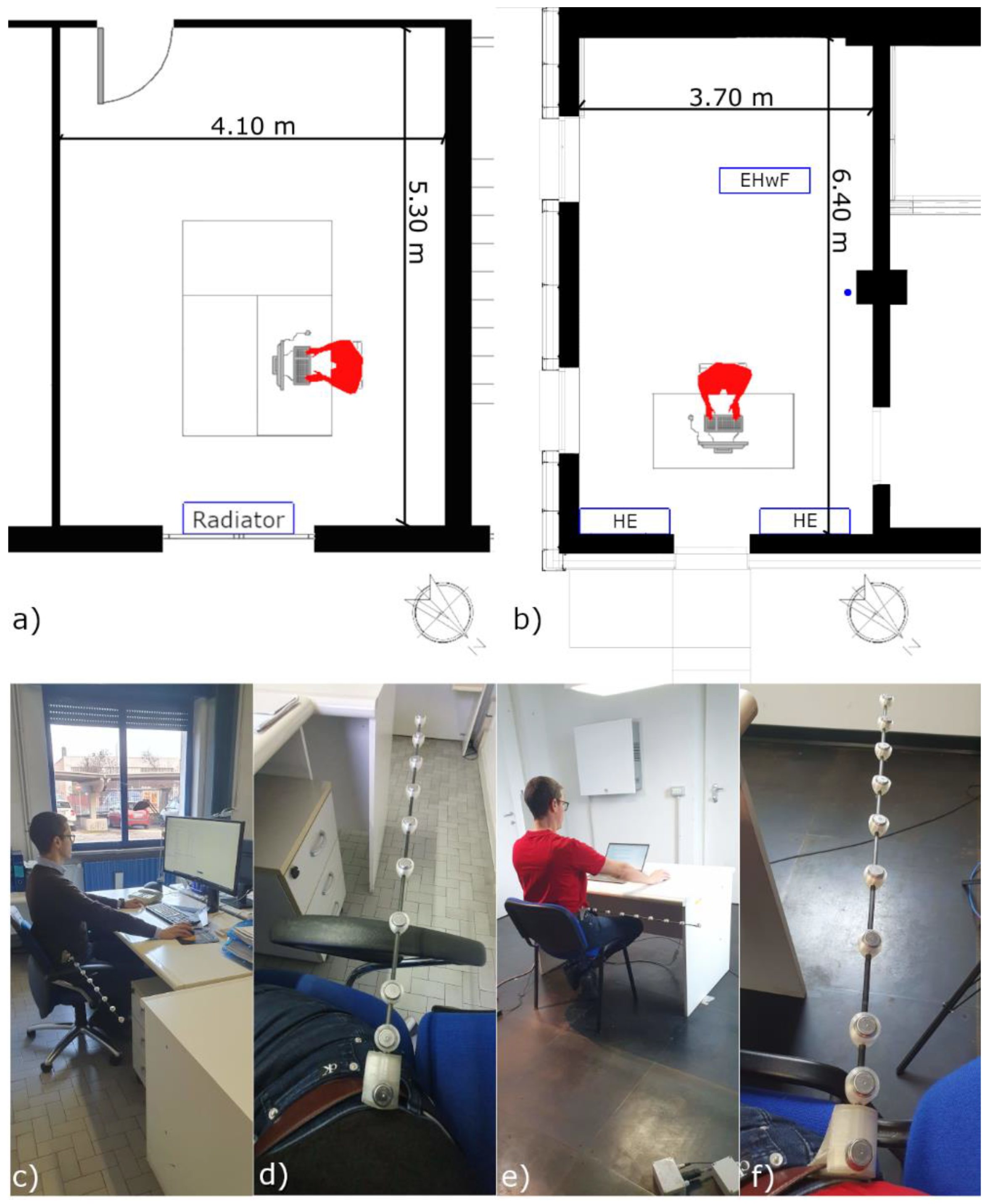
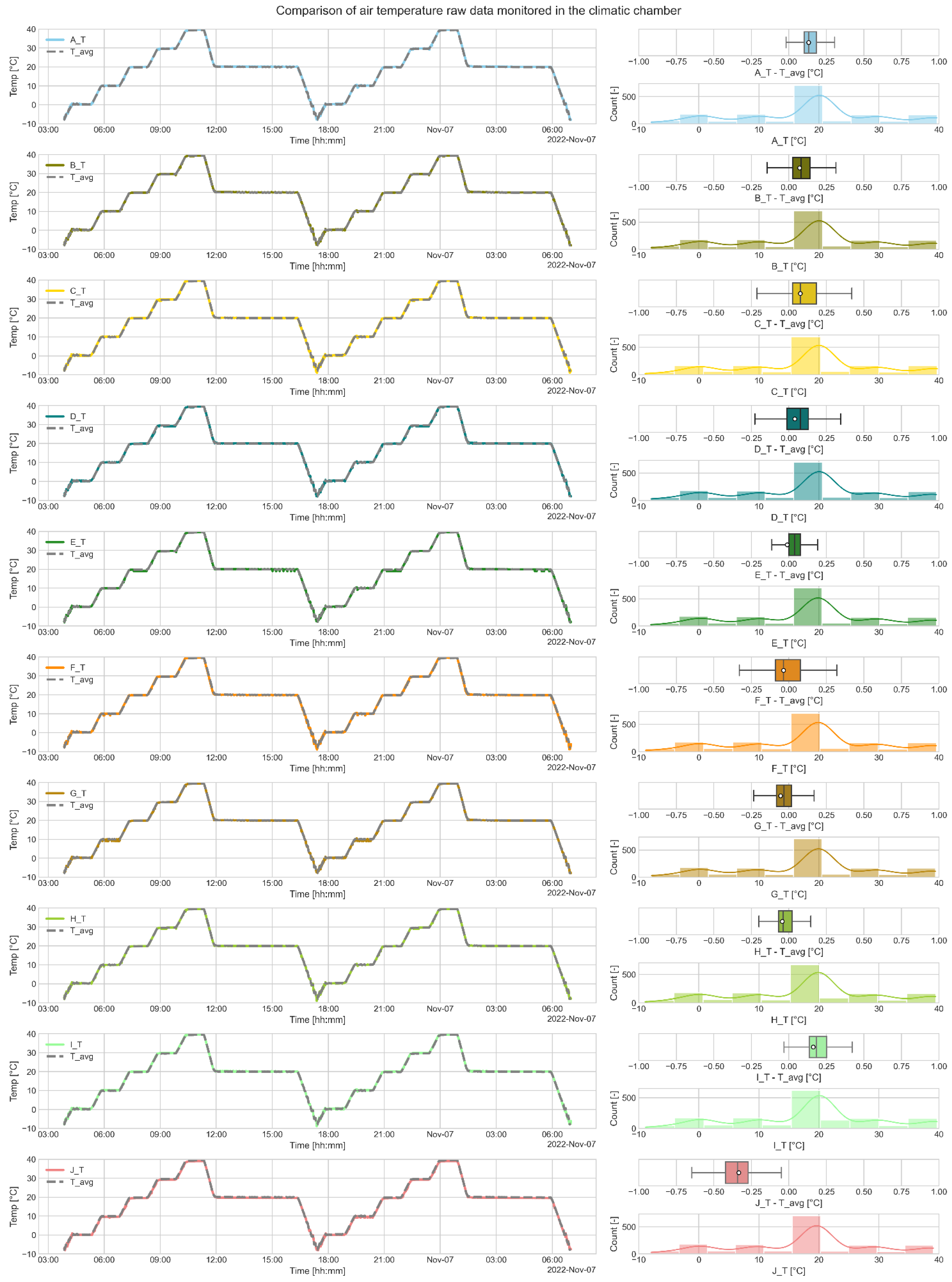
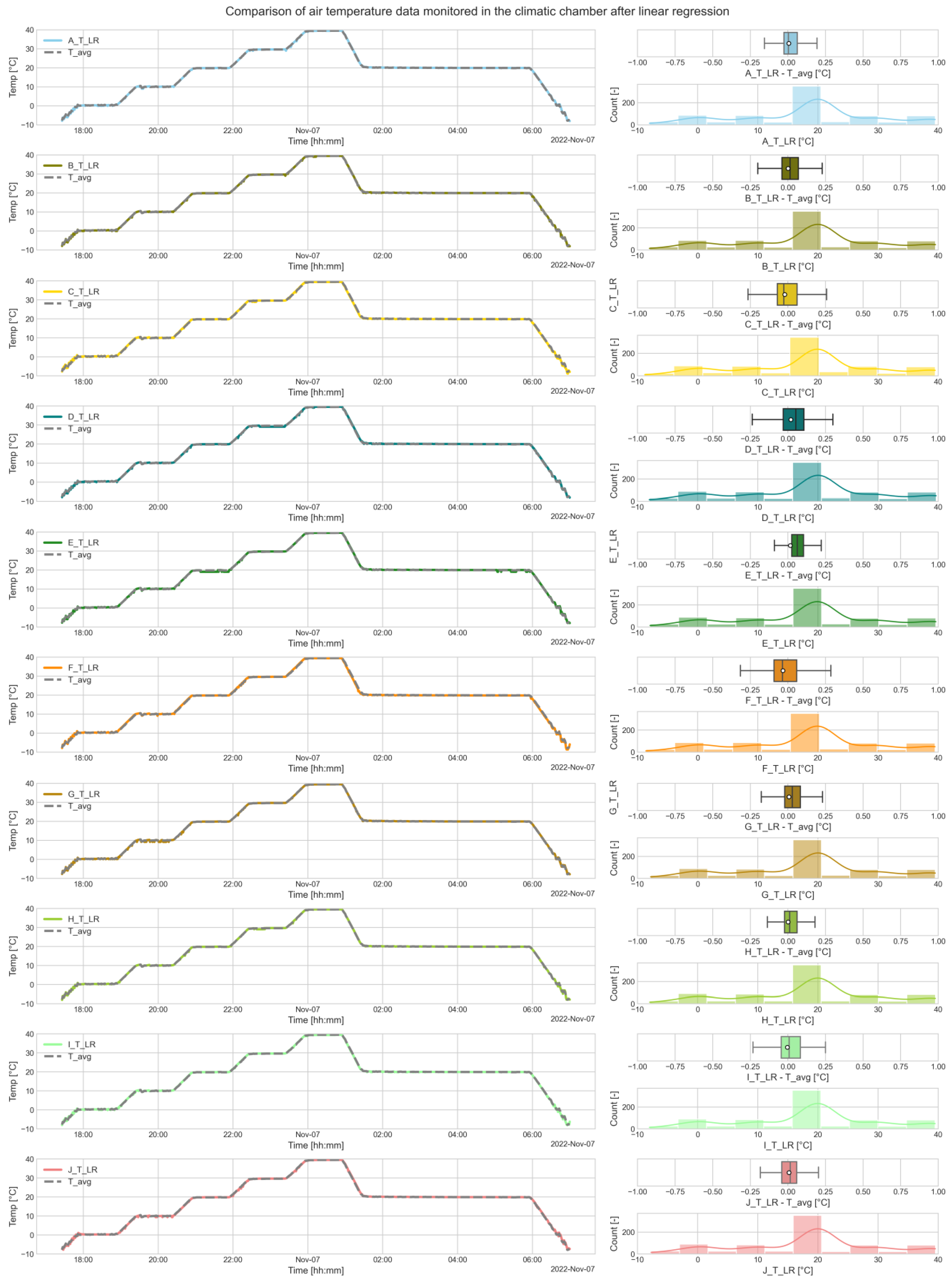


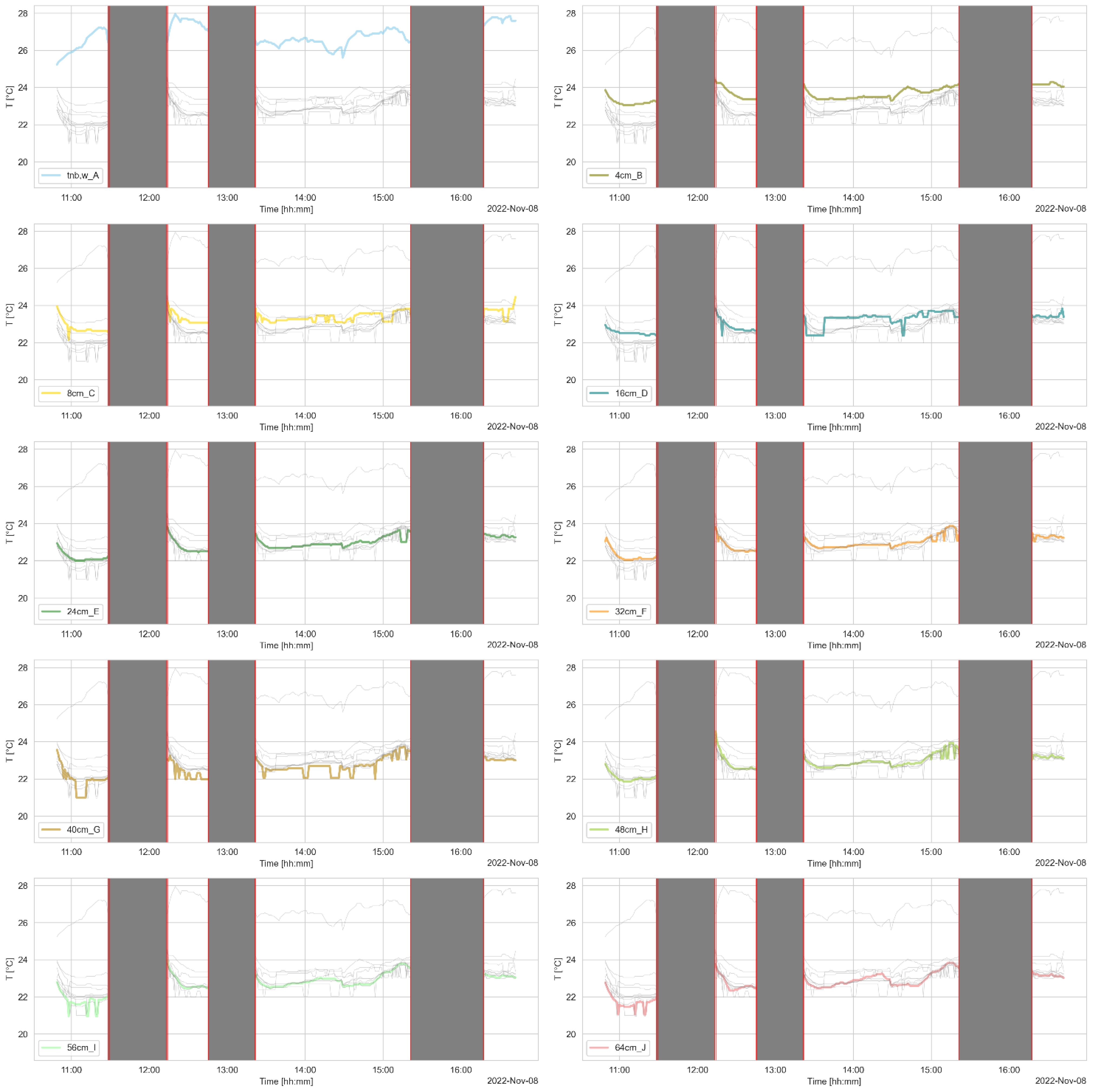
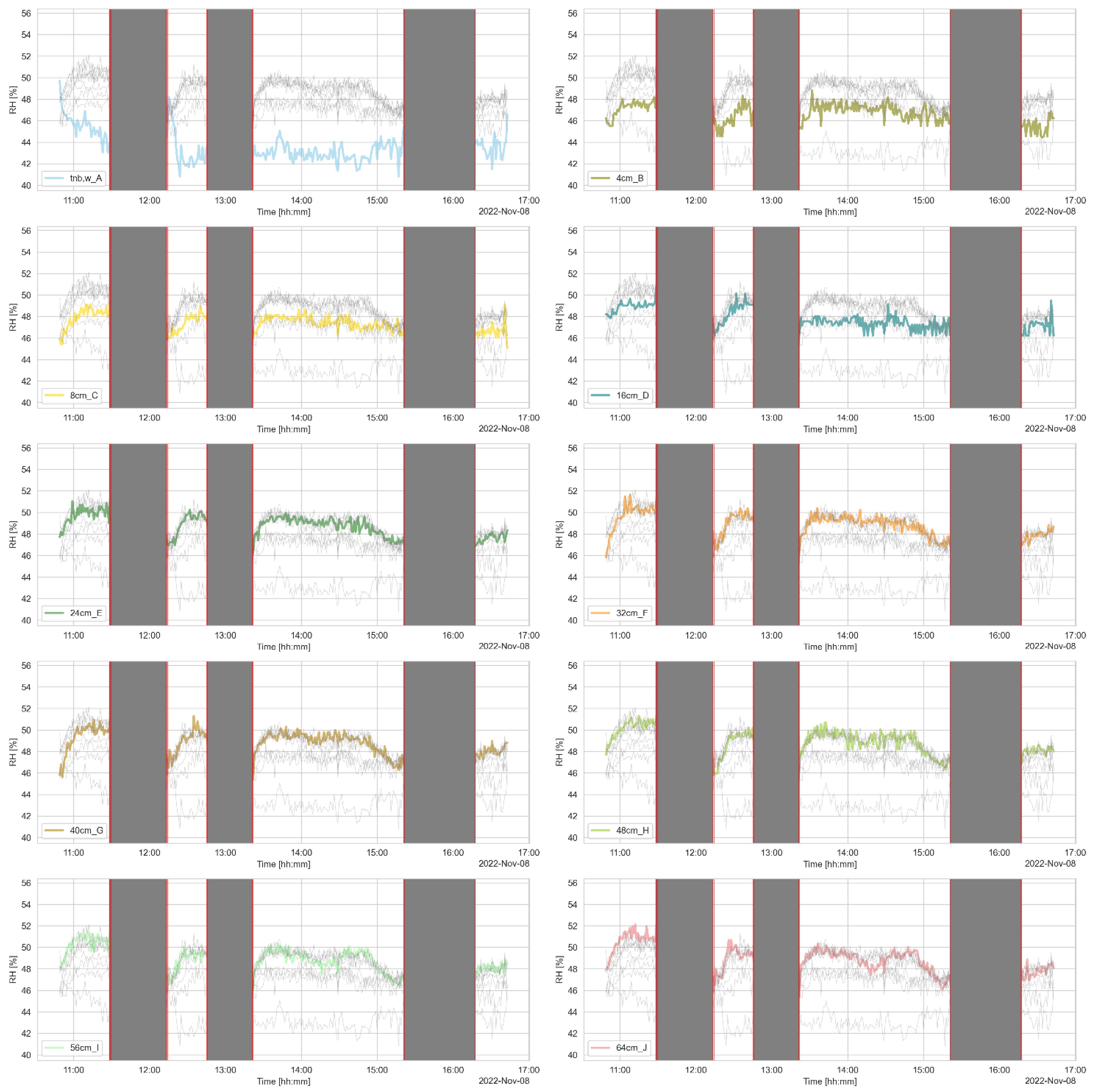
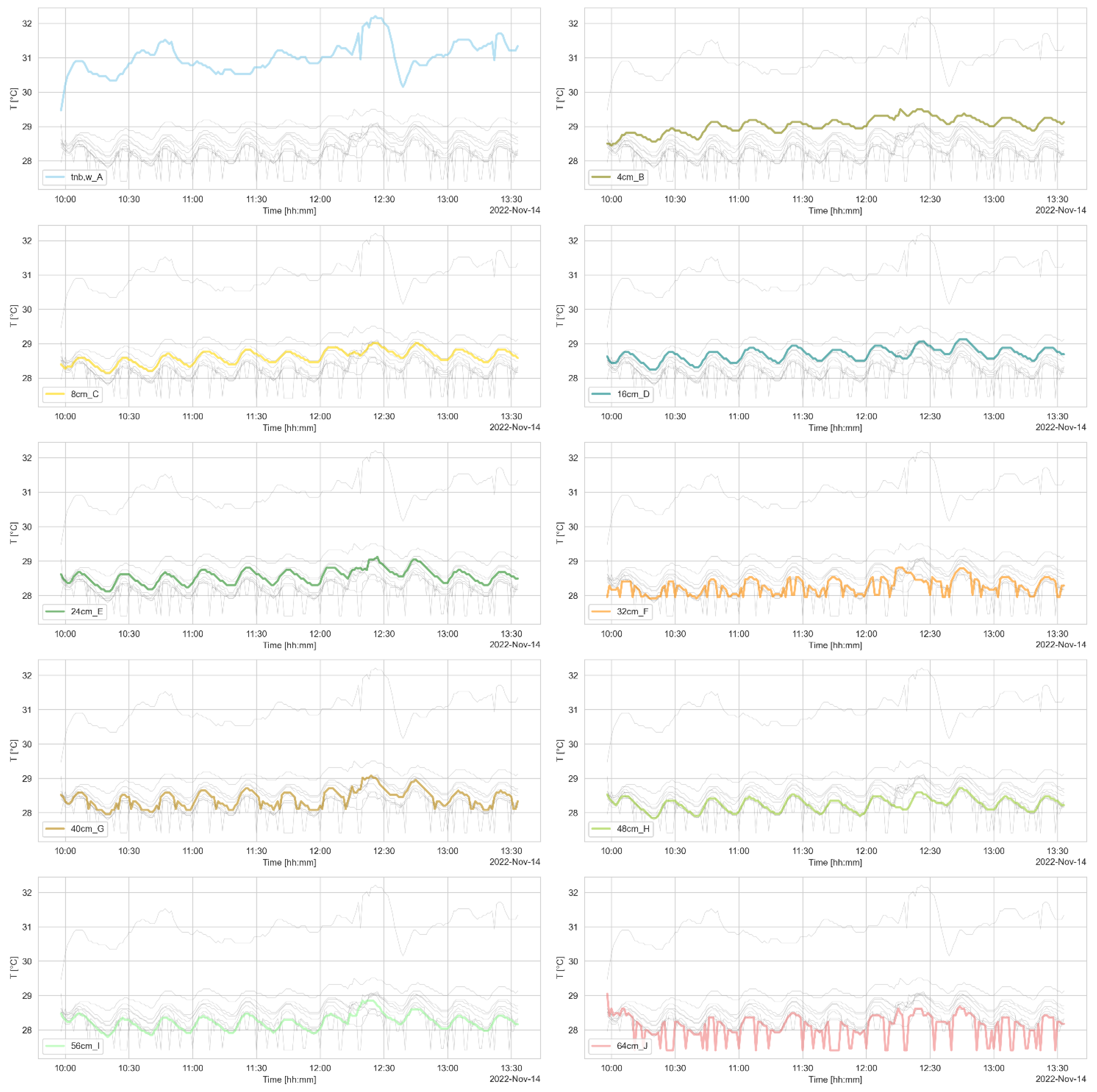
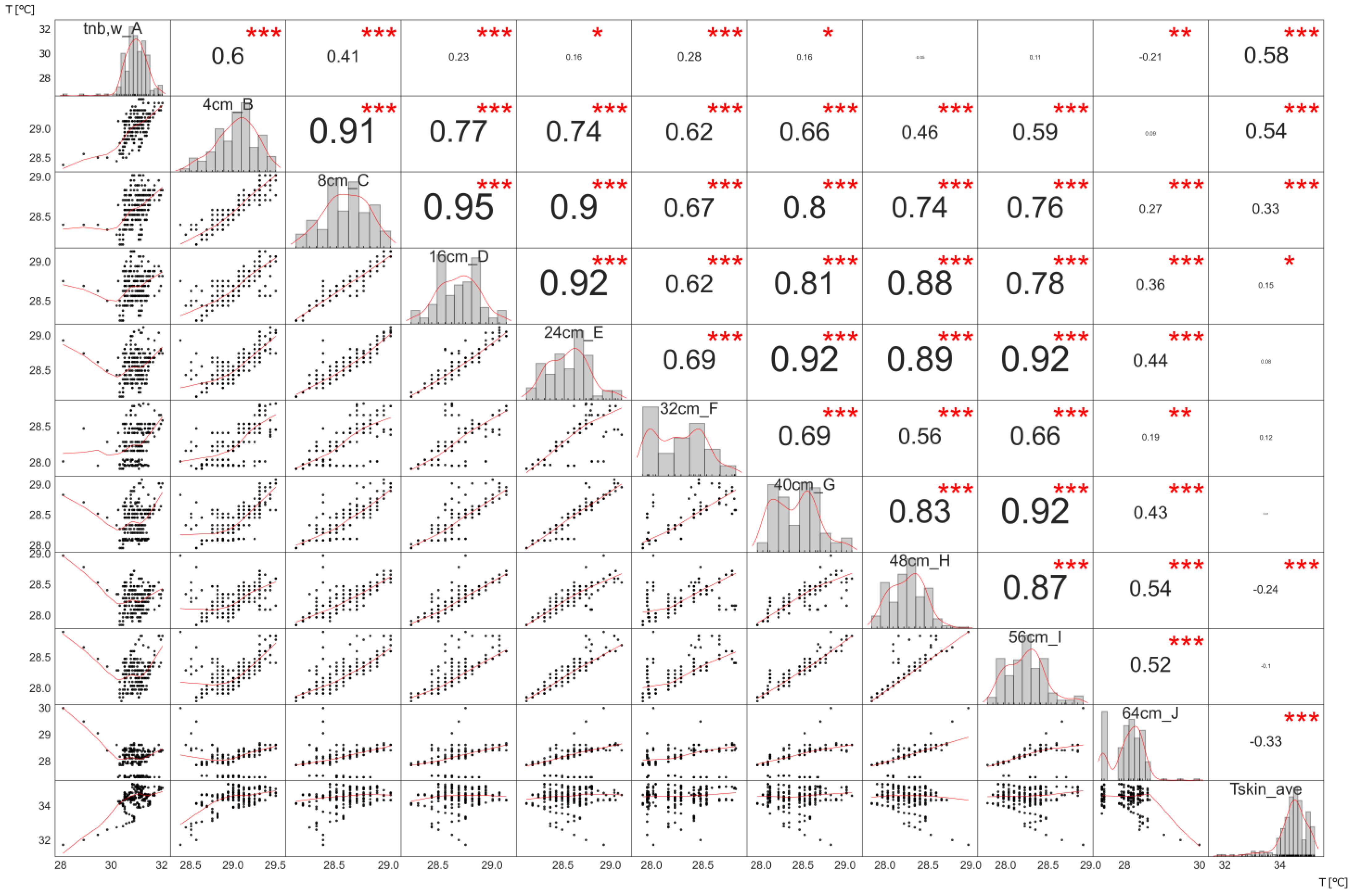
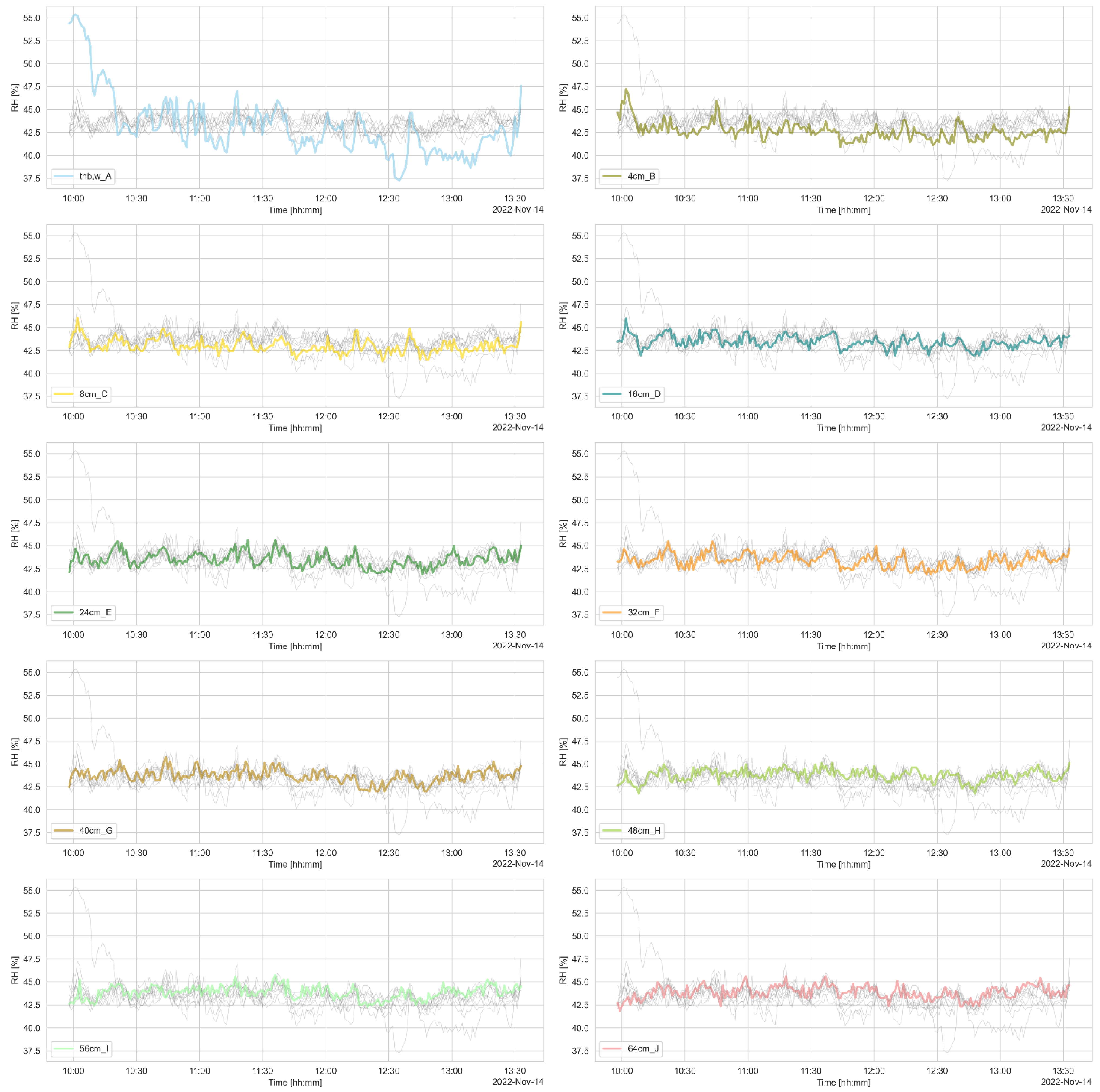
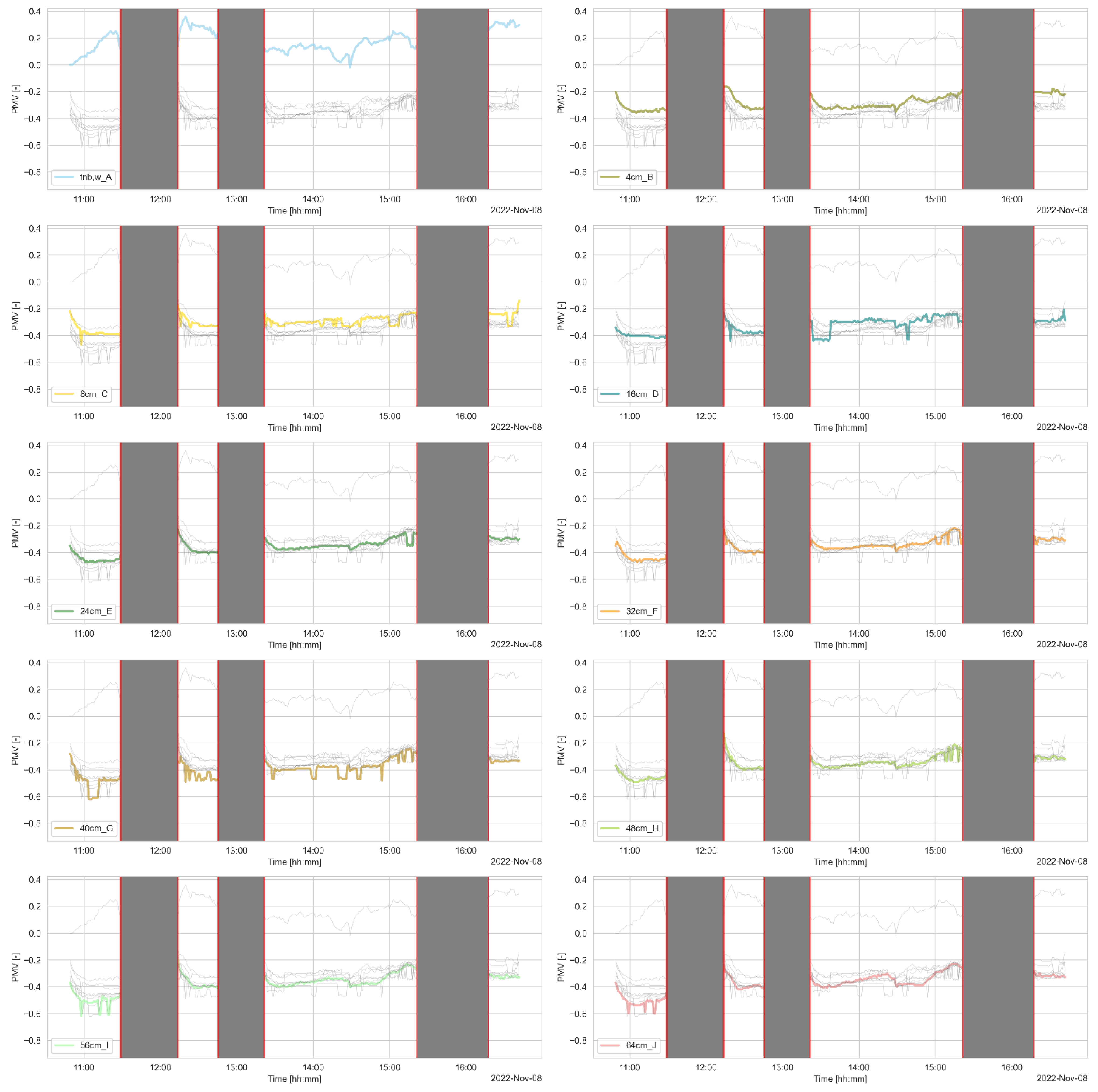
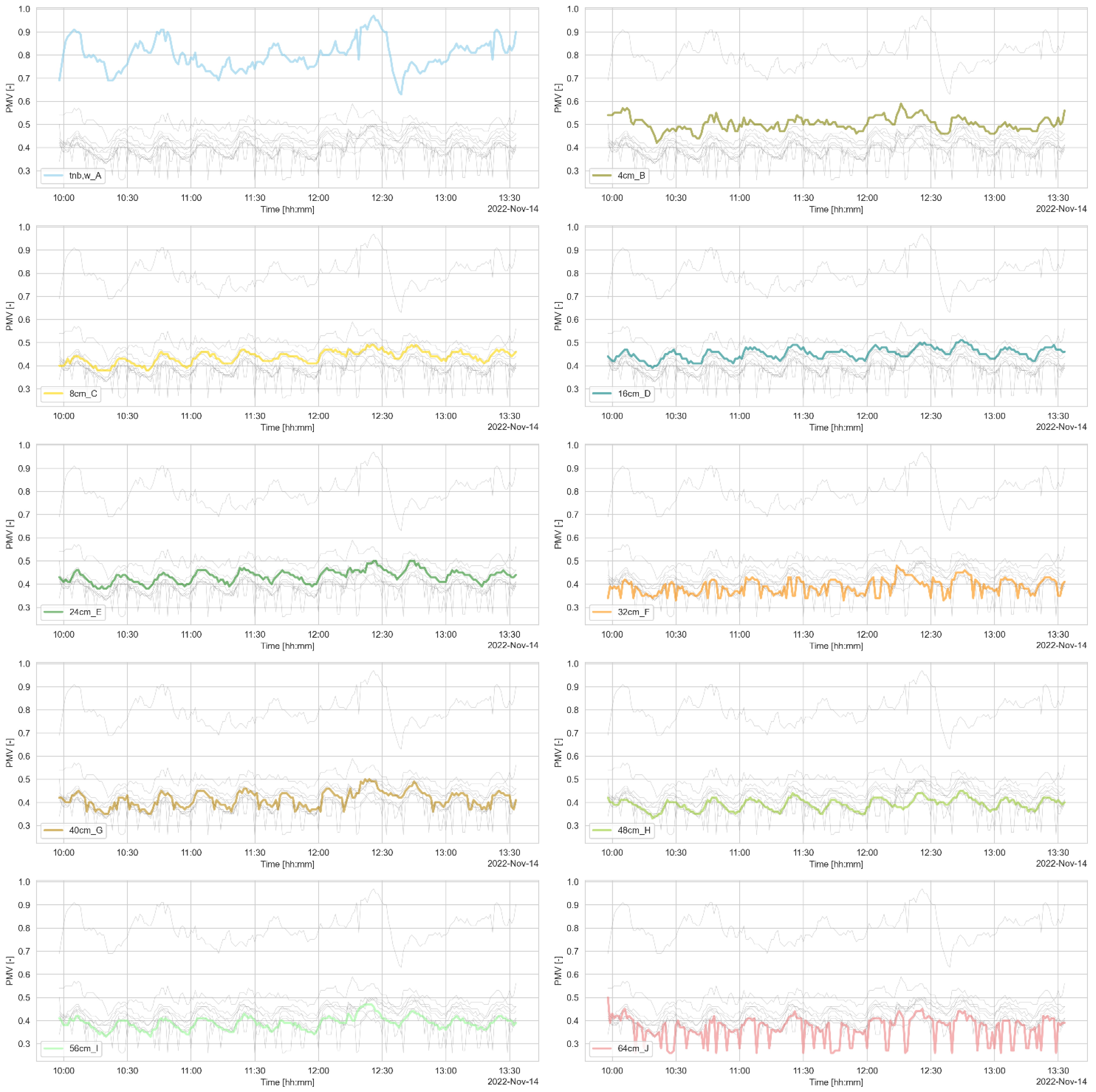
| A | B | C | D | E | F | G | H | I | J | |
|---|---|---|---|---|---|---|---|---|---|---|
| m | 0.9988 | 1.0001 | 0.9934 | 1.0044 | 1.0004 | 0.9946 | 1.0007 | 1.001 | 0.9978 | 1.0053 |
| q | −0.104 | −0.07 | 0.0232 | −0.1031 | 0.0161 | 0.1032 | 0.0544 | 0.0273 | −0.1339 | 0.2521 |
| A | B | C | D | E | F | G | H | I | J | |
|---|---|---|---|---|---|---|---|---|---|---|
| m | 0.9954 | 1.0007 | 1.0127 | 0.9912 | 1.0045 | 1.0192 | 0.9753 | 0.9968 | 1.01 | 0.9832 |
| q | 0.766 | 0.3203 | −0.1757 | 0.2963 | −0.1073 | −0.4822 | 0.2039 | 0.8712 | −0.9748 | −0.0579 |
Disclaimer/Publisher’s Note: The statements, opinions and data contained in all publications are solely those of the individual author(s) and contributor(s) and not of MDPI and/or the editor(s). MDPI and/or the editor(s) disclaim responsibility for any injury to people or property resulting from any ideas, methods, instructions or products referred to in the content. |
© 2023 by the authors. Licensee MDPI, Basel, Switzerland. This article is an open access article distributed under the terms and conditions of the Creative Commons Attribution (CC BY) license (https://creativecommons.org/licenses/by/4.0/).
Share and Cite
Salamone, F.; Danza, L.; Sibilio, S.; Masullo, M. Effect of Spatial Proximity and Human Thermal Plume on the Design of a DIY Human-Centered Thermohygrometric Monitoring System. Appl. Sci. 2023, 13, 4967. https://doi.org/10.3390/app13084967
Salamone F, Danza L, Sibilio S, Masullo M. Effect of Spatial Proximity and Human Thermal Plume on the Design of a DIY Human-Centered Thermohygrometric Monitoring System. Applied Sciences. 2023; 13(8):4967. https://doi.org/10.3390/app13084967
Chicago/Turabian StyleSalamone, Francesco, Ludovico Danza, Sergio Sibilio, and Massimiliano Masullo. 2023. "Effect of Spatial Proximity and Human Thermal Plume on the Design of a DIY Human-Centered Thermohygrometric Monitoring System" Applied Sciences 13, no. 8: 4967. https://doi.org/10.3390/app13084967









